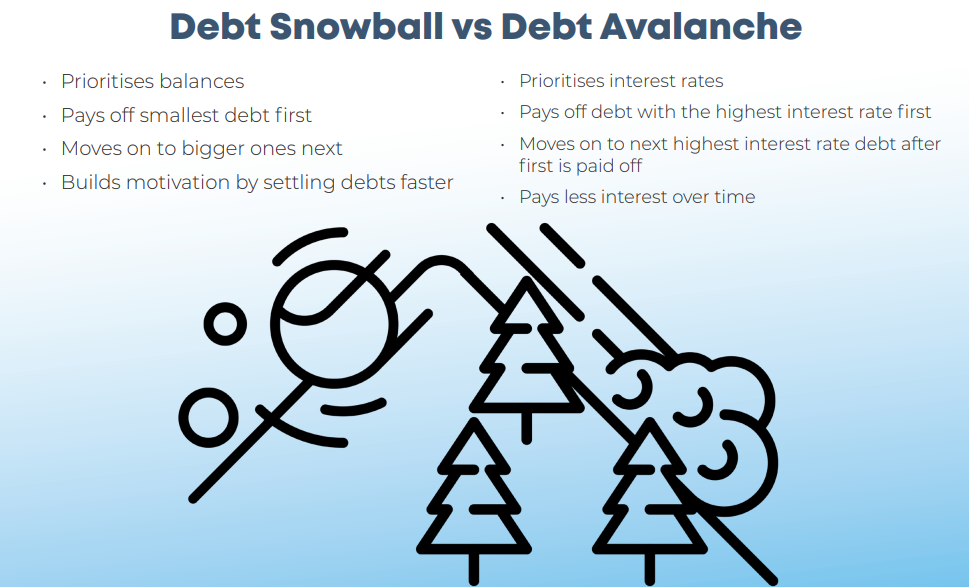Debt can be an overwhelming burden, causing financial stress and obstructing progress towards your goals. Whether it’s credit card balances, student loans, or other debts, finding a strategy to eliminate them effectively is crucial for achieving peace of mind and securing your financial future.
Enter two popular methods: Debt Snowballing and Debt Avalanche. In this article, we’ll explore what these methods are, how they work, and why they can be powerful tools to conquer your debts and pave the way to financial freedom.

Debt Snowballing: The Quick Wins Approach
Debt snowballing is a proven debt repayment strategy that focuses on paying off debts in a specific order, starting with the smallest balance first, regardless of the interest rate associated with each debt. This approach has gained widespread recognition for its simplicity and psychological benefits, making it a favorite among those seeking a motivational approach to debt management.
How Debt Snowballing Works:
- List Your Debts: Create a comprehensive list of all your debts, including outstanding balances and minimum monthly payments, to lay the groundwork for your debt snowball plan.
- Order of Repayment: Arrange your debts in ascending order based on outstanding balances, with the smallest balance taking priority over larger ones.
- Make Minimum Payments: Ensure you continue making minimum payments on all your debts to avoid penalties or negative impacts on your credit score.
- Allocate Extra Funds: Identify additional funds that can be allocated towards debt repayment, such as reducing discretionary expenses, increasing income through side jobs, or reallocating funds from other areas of your budget.
- Target the Smallest Debt First: Focus all extra funds on the debt with the smallest balance. Eliminating smaller debts quickly provides a sense of accomplishment and motivation to continue the debt payoff journey.
- Snowball Effect: Once you pay off the smallest debt, add the amount you were paying towards it to the minimum payment of the next debt on your list. This creates a snowball effect, increasing the amount available for debt repayment with each debt eliminated.
- Repeat and Accelerate: Continue snowballing payments from one debt to the next until all your debts are repaid. As you progress, the amount you can allocate towards debt repayment grows, accelerating your debt payoff timeline.
Why Debt Snowballing is Effective:
- Psychological Momentum: Quick wins from eliminating smaller debts provide a powerful psychological boost, increasing determination to conquer remaining debts.
- Simplified Approach: Focusing on one debt at a time simplifies the process, making it easier to track progress and maintain control over your financial situation.
- Behavioural Change: Debt snowballing encourages positive financial behavior, leading to lasting changes in how you manage your finances.
- Overcoming Debt: While not the most cost-effective method in terms of interest savings, the psychological benefits of debt snowballing can outweigh potential interest costs.
Is Debt Snowballing Right for You?
If you value the psychological and behavioral aspects of debt management and seek a clear and motivational approach to debt repayment, debt snowballing may be your best ally. By starting with small debts and building momentum, it propels you towards better financial outcomes.

Debt Avalanche: The Interest Savings Masterplan
If your top priority is minimizing interest payments, consider the debt avalanche method. This approach prioritizes debts based on their interest rates, allowing you to save more money in the long term.
The Decision: Snowball or Avalanche?
The choice between debt snowballing and debt avalanche depends on your financial goals, personality, and motivations. Debt snowballing may result in paying more interest over time, but the psychological benefits it offers can be invaluable in maintaining motivation and staying on track.
Making the Most of the Debt Snowball Strategy:
- Track Your Progress: Keep a record of your debts, payments, and milestones reached to stay motivated.
- Celebrate Milestones: Reward yourself when you pay off a debt to reinforce positive behaviors and stay motivated.
- Seek Support: Share your debt repayment goals with friends or join online communities for encouragement and accountability.
- Focus on Budgeting and Saving: Prioritize creating a budget aligned with your goals and build an emergency fund to avoid future financial setbacks.
Remember, the journey to becoming debt-free requires discipline, perseverance, and a willingness to change spending habits. Debt snowballing can be your powerful ally to regain control of your finances and pave the way to a more secure financial future. So take charge of your financial journey, embrace the strategy that suits you best, and unlock the door to financial freedom.
So take charge of your financial journey, embrace the strategy that suits you best, and unlock the door to financial freedom. Contact us today for assistance and start your journey to financial freedom!

